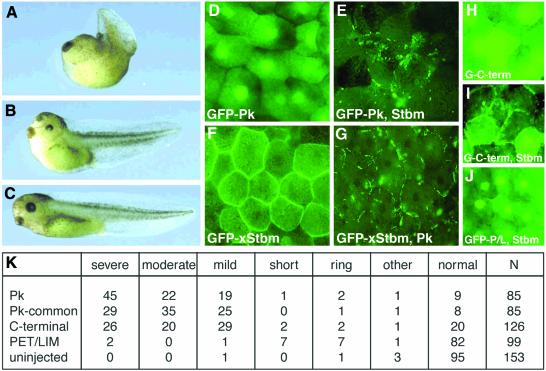Fig. 6. Pk and Stbm affect each other’s localization in Xenopus. (A–C) Severely (A) and moderately (B) affected tadpoles that were injected with 1 ng of Drosophila pk RNA bend dorsally and display a shortened dorsal axis [compared with control embryos (C)], a phenotype associated with CE defects. Embryos pictured are stage 39–40. (D–G) Xenopus Stbm and Drosophila Pk influence each others localization in st. 10 animal cap explants. GFP-Pk shows a mainly cytoplasmic and nuclear localization in the absence of exogenous Stbm (D), while GFP-xStbm uniformly localizes to the plasma membrane in the absence of exogenous Pk (F). Upon coinjection of unmarked xStbm, GFP-Pk is recruited into patches at the cell membrane (E). Similarly, the uniform membrane localization of GFP-xStbm becomes patchy upon coinjection of unmarked Pk (G). (H) GFP-Pk Cterm shows a distribution similar to GFP-Pk when injected alone. (I) Upon coinjection with xStbm, GFP-Pk Cterm partially localizes to the membrane. (J) A GFP fusion of the PET/LIM domain coinjected with xStbm is not recruited to the membrane. (K) Quantification of the effect of Pk fragments on CE. The percentage of embryos with CE defects after injection of 1 ng RNA, of the constructs indicated, are shown. The severe and moderate phenotypes correspond to examples shown in (A) and (B). In mildly affected embryos the head is deflected dorsally with near-normal body length, while in short embryos the overall length is decreased without obvious dorsal flexion. Embryos categorized as rings failed to close the blastopore. Embryos listed as ‘other’ had defects unrelated to CE. Numbers reflect the percentage of embryos in each category, except column N, corresponding to the number of injected embryos. We did not observe a defect when RNA encoding the PET/LIM region fragment was injected, but cannot exclude that the PET/LIM fragment is not translated or preferentially degraded.

An official website of the United States government
Here's how you know
Official websites use .gov
A
.gov website belongs to an official
government organization in the United States.
Secure .gov websites use HTTPS
A lock (
) or https:// means you've safely
connected to the .gov website. Share sensitive
information only on official, secure websites.
